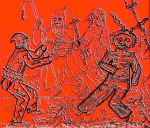
The festivity of San Antonio resembles the Christianization of ancient pre-Christian ceremonies and cults, dedicated to the pastoral devinities of the bestiary, to pray for protection for animals and tools for field work.Benediction of animals reflects some popular beliefs beyond the strict devotion. It is also the gateway to the carnival celebrations.

The presence of demons at the festival of Saint Antony is to explain the adversities, the negative circumstances of the natural environment: floods due to floods of rivers, fires ... as the facts of a negative power that makes it an evil being, opposed to the positive divinity. These demons are more like geniuses of nature, than evil beings. Christianization has not managed to make that character disappear.
Due to the transition of an agricultural economy to an industrial one, many of these rituals have disappeared, but some are still preserved, such as the distribution of "prims, rotllos i panoli" (popular cakes), the procession of "dels tres tombs", especially in the cities of Castelló de la Plana.
If you want to know more, you can consult the "Costumari Català" of Joan Amades and "Sant Antoni, sant valencià " of A. Monferrer.
If you want to know more...
Llibrets de Sant Antoni del Porquet Botafocs
Auca de Sant Antoni del Porquet Botafocs
Vida de Sant Antoni del Porquet Botafocs
Most of the peoples of ancient civilizations celebrated the summer solstice, the time of the year when the Sun is at the highest point of the zenith. This is visible for a longer period of time, being therefore the moment of its maximum luminosity and the longest day of the year.
This natural fact has not gone unnoticed throughout history, so in Greece they started the year for the summer solstice. It was the Apollo festivity, during which they fire up large bonfires with purifying character.
The festivities and customs of Saint John are very reminiscent of the Roman festivals in honor of Palas Athena, who was the deity of fire.

EnThere are three main customs in the Middle Ages: the lighting of bonfires, the processions through the fields with burning torches and the rolling of large wheels with burning branches.

The protagonist of this magical night is the Sun, which, symbolically, we make to last in all the bonfires that are fire up throughout the night in the whole Mediterranean coast, in all the summits, squares and streets of our towns and cities.The custom is to collect wood, old furniture for the fires that will help the purification, renewal, good luck and that the evil spirits remain far away. Firecrackers also participate in this task.
All of this has to be shared with the community, family, friends ... Saint John is also synonymous with sea baths, or any water source, or river, to take advantage of the healing properties of the waters, and that is why...
If you want to know more...
Llibrets de Sant Joan Botafocs
LA NIT DE SANT JOAN J. Romeu Ed. Altafulla, 1993.
COSTUMARI CATALÀ Joan Amades Ed. Salvat, 1984